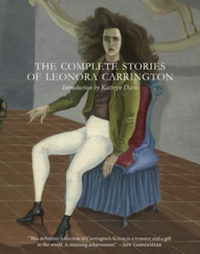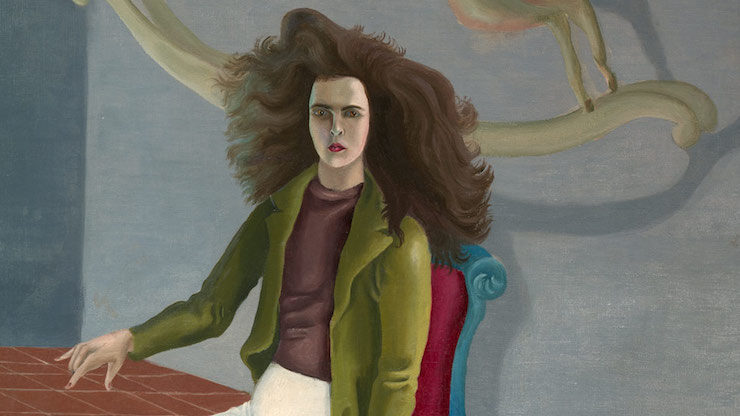“Her two feet are left over still, but if you have a little bag, I’ll eat them later in the day.” So speaks a hyena on page six of “The Debutante,” the opener to The Complete Stories of Leonora Carrington. The hyena, a personal friend of the narrator, has just killed the narrator’s maid so that she can “nibble” off her face and take the narrator’s place at a truly tedious ball: “I certainly wouldn’t have done it if I didn’t hate having to go to a ball so much.”
“The Debutante,” remarkable even if you didn’t know Carrington wrote it in her very early twenties, is not an outlier: Every story in this collection is as surprising, as vicious, and as memorable.
Although she wrote short stories, novellas, a novel, a play, children’s stories, and a memoir, Leonora Carrington remains best known as a Surrealist painter. Her books have not always remained in print, but her paintings, drawings, and prints have hung for decades in the world’s great museums. April 2017 would have marked Carrington’s hundredth birthday; The Complete Stories publishes this month to celebrate her centennial, as does her memoir, Down Below.
The Surrealists, with their games of Exquisite Corpse and their penchant for automatic writing, were lovers of the fortuitously random, and one can almost imagine Carrington’s Complete Stories serving as a Surrealist I Ching. Every page contains something to prod, provoke, shock, puncture, enlighten, or inspire the lucky reader. Here are some examples:
“In seven years your skin will be like stars, in seven years you will have the holy disease of the Bible, leprosy!”
“A house discreetly surrounded by wild plants and underclothes of bygone times.”
“Do you believe,” she went on, “that the past dies?”
“Yes,” said Margaret. “Yes, if the present cuts its throat.”
“The Misses Cunningham-Jones, each armed with a huge whip, were whipping the vegetables on all sides, shouting, ‘One’s got to suffer to go to Heaven. Those who do not wear corsets will never get there.’”
“Unfortunately the Church forbids private assassination. I’m therefore obliged to ask you to come to my assistance. You’re a Protestant, aren’t you?”
“Thibaut, who was a great deal younger than Cyril de Guindre, had golden skin like the corpse of a child preserved in an old and excellent liqueur. He wore an elegant dressing gown the colour of trout flesh and his face, behind the roses, was livid with anger.”
 The stories feature, amongst many other things: Aztec gods, suicidal vegetables, medicines derived from the mustache hairs of a preserved miniature Stalin doll mysteriously delivered to a lottery winner in a post-apocalyptic cemetery, a woman who transforms into a horse, flagellant saints, a walking and talking Happy Corpse with a mouth in the back of its head, and a narcissistic one-eyed boar who begins a family with a wild woman. I would call the stories dreamlike if only I’d ever had a dream as bizarre and memorable as a Carrington stories.
The stories feature, amongst many other things: Aztec gods, suicidal vegetables, medicines derived from the mustache hairs of a preserved miniature Stalin doll mysteriously delivered to a lottery winner in a post-apocalyptic cemetery, a woman who transforms into a horse, flagellant saints, a walking and talking Happy Corpse with a mouth in the back of its head, and a narcissistic one-eyed boar who begins a family with a wild woman. I would call the stories dreamlike if only I’d ever had a dream as bizarre and memorable as a Carrington stories.
Art historians call a canvas “painterly” when the artist’s brushstrokes are obvious and visible; a painterly work calls attention to the method of its own creation. Painterly prose, I think, calls attention to the author’s cleverness. Neither Carrington’s paintings nor her prose are at all painterly: we see what she sees, as if the intermediaries of word or paint have vanished. She evokes in her readers the same wry amusement she feels at “all the titillating activities, including suffering, happiness, esthetic enjoyment, self-importance, politics and football, etc.”
If there’s a significant problem with Carrington’s stories, it’s that they rarely excite emotional involvement: her archetypes and alter egos—“Leonora Carrington” is occasionally a character—tend to be thinly drawn and subservient to the wonders and horrors they share the page with. We get a fine sense of the interior world of Leonora Carrington and of the dreams, wonders, and fears she has, but the stories are explorations of her unconscious; they will move reader’s intellect more than their emotion. Similarly, the reflexive Surrealist anti-clericalism and automatic distrust of authority grow slightly repetitive when the stories are read in quick succession. I recommend you read this collection slowly: Carrington wrote these stories over the course of several decades, and it’s best to give each story time to work on your mind.
The twenty-five tales in The Complete Stories of Leonora Carrington occupy just over two hundred pages; it’s a slim book that many readers will wish was longer. Down Below, despite a substantial biographical introduction from Marina Warner, is less than half as long, but at times its hundred-page length seems interminable, so acute is the suffering Carrington relates. The artist was living in France with her fellow Surrealist Max Ernst when the Second World War began. Ernst was interned by the French, then released and arrested by the Germans. His lover fled with friends to Madrid, where she suffered an extreme mental breakdown. Three years later, Carrington related the story of her breakdown, though Down Below did not appear as a book in English for several decades.
 Carrington’s hallucinations are paranoid and persuasive: “When the telephone rang or fell silent, answering or refusing to answer me, it was the inner voice of the hypnotized people of Madrid (there is no symbol hidden here, I am speaking literally).” She plans to cure General Franco of his hypnotism and return the world to peace, but the British consul in Spain recognizes her mental state and arranges a brutal intervention.
Carrington’s hallucinations are paranoid and persuasive: “When the telephone rang or fell silent, answering or refusing to answer me, it was the inner voice of the hypnotized people of Madrid (there is no symbol hidden here, I am speaking literally).” She plans to cure General Franco of his hypnotism and return the world to peace, but the British consul in Spain recognizes her mental state and arranges a brutal intervention.
Delivered to a sanatorium, injected with drugs, Carrington contemplates “the stopping of my mind for all eternity in the essence of utter anguish.” Even speaking about this era remained painful for Carrington: “How can I write this when I’m afraid to think about it? I am in terrible anguish, yet I cannot continue living alone with such a memory.” Carrington recovered, moved to Mexico, and lived the remainder of her long life—she lived to ninety-four—without a relapse, though Warner makes it clear that the prospect of a recurrence haunted her. Even were it not the work of a genius painter and writer, Down Below’s combination of bravery and candor would make it a vital testament.
The Complete Stories and Down Below are both remarkable books; read together they are almost overwhelming. The Carrington centennial should stand as one of the great literary events of 2017. I know that I will be pressing these books on friends, family, and acquaintances for years to come.
Matt Keeley reads too much and watches too many movies; he is helped in the former by his day job in the publishing industry. You can find him on Twitter at @mattkeeley.










